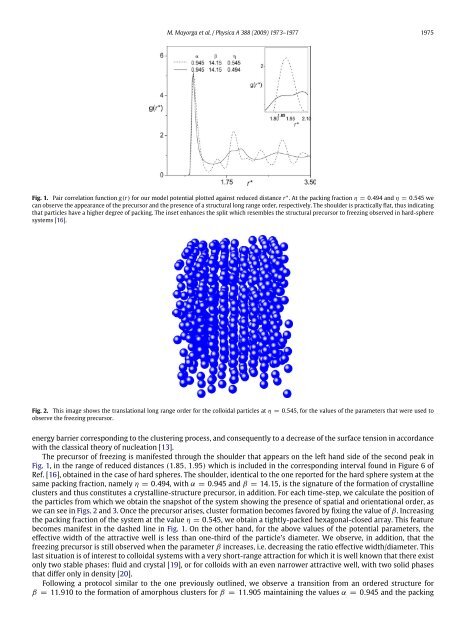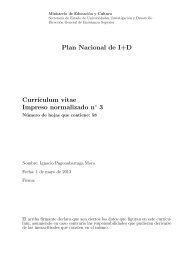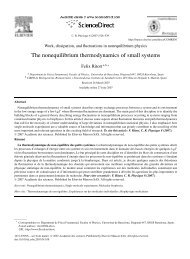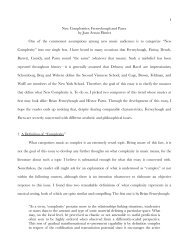Physica A Precursors of long-range order and local disorder in colloids
Physica A Precursors of long-range order and local disorder in colloids
Physica A Precursors of long-range order and local disorder in colloids
Create successful ePaper yourself
Turn your PDF publications into a flip-book with our unique Google optimized e-Paper software.
M. Mayorga et al. / <strong>Physica</strong> A 388 (2009) 1973–1977 1975Fig. 1. Pair correlation function g(r) for our model potential plotted aga<strong>in</strong>st reduced distance r ∗ . At the pack<strong>in</strong>g fraction η = 0.494 <strong>and</strong> η = 0.545 wecan observe the appearance <strong>of</strong> the precursor <strong>and</strong> the presence <strong>of</strong> a structural <strong>long</strong> <strong>range</strong> <strong>order</strong>, respectively. The shoulder is practically flat, thus <strong>in</strong>dicat<strong>in</strong>gthat particles have a higher degree <strong>of</strong> pack<strong>in</strong>g. The <strong>in</strong>set enhances the split which resembles the structural precursor to freez<strong>in</strong>g observed <strong>in</strong> hard-spheresystems [16].Fig. 2. This image shows the translational <strong>long</strong> <strong>range</strong> <strong>order</strong> for the colloidal particles at η = 0.545, for the values <strong>of</strong> the parameters that were used toobserve the freez<strong>in</strong>g precursor.energy barrier correspond<strong>in</strong>g to the cluster<strong>in</strong>g process, <strong>and</strong> consequently to a decrease <strong>of</strong> the surface tension <strong>in</strong> accordancewith the classical theory <strong>of</strong> nucleation [13].The precursor <strong>of</strong> freez<strong>in</strong>g is manifested through the shoulder that appears on the left h<strong>and</strong> side <strong>of</strong> the second peak <strong>in</strong>Fig. 1, <strong>in</strong> the <strong>range</strong> <strong>of</strong> reduced distances (1.85, 1.95) which is <strong>in</strong>cluded <strong>in</strong> the correspond<strong>in</strong>g <strong>in</strong>terval found <strong>in</strong> Figure 6 <strong>of</strong>Ref. [16], obta<strong>in</strong>ed <strong>in</strong> the case <strong>of</strong> hard spheres. The shoulder, identical to the one reported for the hard sphere system at thesame pack<strong>in</strong>g fraction, namely η = 0.494, with α = 0.945 <strong>and</strong> β = 14.15, is the signature <strong>of</strong> the formation <strong>of</strong> crystall<strong>in</strong>eclusters <strong>and</strong> thus constitutes a crystall<strong>in</strong>e-structure precursor, <strong>in</strong> addition. For each time-step, we calculate the position <strong>of</strong>the particles from which we obta<strong>in</strong> the snapshot <strong>of</strong> the system show<strong>in</strong>g the presence <strong>of</strong> spatial <strong>and</strong> orientational <strong>order</strong>, aswe can see <strong>in</strong> Figs. 2 <strong>and</strong> 3. Once the precursor arises, cluster formation becomes favored by fix<strong>in</strong>g the value <strong>of</strong> β. Increas<strong>in</strong>gthe pack<strong>in</strong>g fraction <strong>of</strong> the system at the value η = 0.545, we obta<strong>in</strong> a tightly-packed hexagonal-closed array. This featurebecomes manifest <strong>in</strong> the dashed l<strong>in</strong>e <strong>in</strong> Fig. 1. On the other h<strong>and</strong>, for the above values <strong>of</strong> the potential parameters, theeffective width <strong>of</strong> the attractive well is less than one-third <strong>of</strong> the particle’s diameter. We observe, <strong>in</strong> addition, that thefreez<strong>in</strong>g precursor is still observed when the parameter β <strong>in</strong>creases, i.e. decreas<strong>in</strong>g the ratio effective width/diameter. Thislast situation is <strong>of</strong> <strong>in</strong>terest to colloidal systems with a very short-<strong>range</strong> attraction for which it is well known that there existonly two stable phases: fluid <strong>and</strong> crystal [19], or for <strong>colloids</strong> with an even narrower attractive well, with two solid phasesthat differ only <strong>in</strong> density [20].Follow<strong>in</strong>g a protocol similar to the one previously outl<strong>in</strong>ed, we observe a transition from an <strong>order</strong>ed structure forβ = 11.910 to the formation <strong>of</strong> amorphous clusters for β = 11.905 ma<strong>in</strong>ta<strong>in</strong><strong>in</strong>g the values α = 0.945 <strong>and</strong> the pack<strong>in</strong>g





